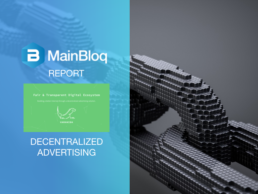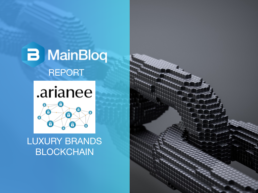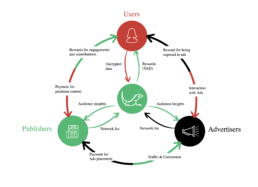Varanida: the Monitor Lizard of Internet Ads
The term “Varanida” comes from the official scientific designation for a monitor lizard, the Varanidae. This genus got the less formal name “monitor” due to the way in which such lizards will sometimes rear themselves up on their front legs to get a good look around, to monitor their environment, as the little fellow in the Varanida logo seems to be doing.
The omnivorous appetite of these creatures has given them a reputation for cleaning out mangroves and fields. Thus, they are a suitable mascot for a technology designed to clean out the messy internet marketing ecosystem.
Accordingly, in this newly announced project, Varanida, a company based in France, promotes a Verified Ad Program (VAD) in an effort to redefine internet marketing, using blockchains for their decentralization, fraud-resistance, and transparency.
The User Interface
Varanida has developed an add-in or extension for Google Chrome and Mozilla Firefox browsers. The extension will allow the internet user, including one with no technical sophistication, to block irritating internet ads, as detailed in their White Paper.
That idea isn’t very surprising, there are lots of ad blockers out there. What is more important, the user of Varanida’s extension, in blocking ads for him/herself, is helping to block them for a broader network of users as well (which might be a satisfying fact in itself) and is earning tokens with real near-term uses. We’ll get back to those points soon enough below.
Enthusiastic Founders
The CEO, and one of the founders of Varanida, is Anji Ismaïl, a blockchain enthusiasts who advises on a number of blockchainprojects, and who has created a cryptocurrency mining operation.
Varanida is a new expression of Ismaïl’s established interest in internet marketing. He is also the co-founder of DOZ.com, which he once described to Venturebeat as “the Uber of marketing campaigns.” The idea behind it was that a website owner should be able to order up a marketing campaign remotely, from the cloud so to speak, from marketers who (like Uber’s drivers) are paid per task.
The restructuring of Varanida has a much broader scope and purpose than that of DOZ but it is in the same line of progress. And one of Ismaïl’s co-founders is Faouzi El Yagoubi (also a co-founder of DOZ). The other is Thomas Schmider.
El Yagoubi is the chief technology officer, Schmider (whose resume includes the co-founding of Infogrames, the company that in due course purchased Atari) is the chief operating officer.
Yagoubi recently contributed a thoughtful piece to Medium about blockchains, decentralization, and encryption, one which helps make the thinking at Varanida transparent. He said that decentralization has many benefits, but there are some processes that just can’t be accomplished “the way we need them to be” without centralization. He wrote that Varanida’s real-time billing system will need to handle “real-time workloads and still provide a high level of fault tolerance” so the management group is “considering a hybrid approach, with a centralized computer system, and a decentralized ordered-hash storage system” to provide “the best of both worlds.”
Other Members of the Team
The other members of the managerial team include three distinguished software engineers: Pierre Antoine Meley, Mickael Crozes, and Marc Vicenti.
Meley has an electronics, information tech, and signal processing background. Crozes, who has a masters in computer science from SUPINFO International University, comes to Varanida with a lot of technical infrastructure experience at Amazon.com. Vicenti has a background in artificial intelligence and signed his first transaction with the Bitcoin Mainnet in 2012.
Also on board: Mathieu Sibille, senior vice president of business development (with experience in APAC, EMEA, and eastern Europe) and Jon Lord, senior ad tech consultant, who managed international sales and account teams at TradeDoubler and, more recently, worked at Criteo, a company that provides personalized online display advertisements.
Media Savvy Advisors
Varanida’s line-up of early investors and advisors displays a valuable range of backgrounds and new/social media savvy.
These advisors include, for example, Joel Comm, the bestselling author of The AdSense Code (2006) and Twitter Power (2009).
Also: Jean Christophe Conti is in. Formerly he was VP and head of the partnerships group at Yahoo where he was in charge of all partnerships, both desktop and mobile, in EMEA for: the Yahoo Display Ad Network, Yahoo Search Affiliate Network; and Right Media Platform & Exchange. of Sales for the Publishers Business Unit EMEA at AppNexus. More recently, Conti has been VP of Sales for publishers business unit, EMEA, at AppNexus.
Further, there’s Thomas Hessler, an early blockchain enthusiast and a co-founder of former CEO of Zanox, which under his leadership grew to become a global market leader in performance based online marketing until, in 2007, it was acquired by two media giants Axel Springer (Germany) and PubliGroupe (Switzerland).
We’ll mention just one more name from this field: Frédéric Montagnon is an early investor in and advisor to Varanida. Its white paper describes him as “a very active angel investor in various technology sectors.” He launched both Secret Media (an ad blocker monetization company) and Legolas Exchange (a decentralized crypto-exchange). This January Legolas raised more than $35M through its ICO in January 2018.
Montagnon recently predicted, to a reporter for a magazine that reports on the luxury industry: “Really soon everybody will be using blockchain technology in their daily lives without even noticing it the same way you use the Web without a deep understanding of how TCP-IP or HTTP works." [The point of the story was that blockchain would reduce the counterfeiting of luxury brand name goods.]

Users, Marketers, Publishers
How Varanida benefits to Publishers
But let us return to what these individuals, combined in the persona of a lizard, are up to. The Varanida white paper looks at a number of the problems that now attend internet advertising from three different points of view: that of the users, the advertisers, and the publishers of internet content.
Most users surveyed (91%) agree that ads have become even more intrusive than they were just two or three years ago. Users don’t necessarily believe that ads are bad, but the clutter of ads makes it difficult to distinguish which ones might actually be offering something valuable. Also, users are concerned that they’ve lost control over how their personal data is employed once it is ‘out there’ on the net. Indeed, most users (86%) say they have taken steps to remove digital footprints because they don’t like being targeted and pursued by the demographic characteristics and interests they have displayed.
How Varanida benefits to Advertisers
From the point of view of the advertisers, of course, “banner blindness,” the condition in which users have learned to ignore ads and focus on content, is undesirable. Marketers want their ads to reach people, and not merely to be there on the screen. The average click-through rate for a banner ad is now around 0.05%, which is enough to make one nostalgic for the ‘90s and grunge rock.
From a publishers’ point of view, too, the system is broken. Two fifths of publishers report that their ad revenues are now static or declining. They face a problem of scaling. Only a small number of publishers have the technical capabilities or the audience size necessary to serve the needs of the large advertising clients. The advertisers know this and are increasingly avoiding the small and even medium sized publishers. So even though more money than ever before gets spent on digital advertising -- if a publisher isn’t Google or Facebook, it probably isn’t getting much of it.
Meanwhile, younger users (the most desired eyeballs in the system) have caught on to the availability of ad blockers, which the Varanida white paper calls “the publishers’ nightmare.” Ad blockers now on the market don’t give users a lot of control, they aren’t customized to let users view what they would regard as useful advertising while blocking the rest.
For the reasons mentioned here, and others, it is clear to the people driving Varanida that internet advertising will have to change. Their goal is to mold that change.
How the Lizard will Work
The underlying idea is that Varanida will but itself in the center of this triangle of dissatisfied parties: users, marketers, and publishers. Users will agree to look at high-quality advertising, and will receive VAD tokens when they do. So the users win.
Advertisers and publishers will each pay a network fee. But they also win, because the new system will solve their problems as discussed above. Publishers -- except presumably for Facebook and Google, which might both want to preserve their unique status under the present system -- win by paying a fair value price for their advertising and preserving their engagement with the audience. The advertisers win by getting a fair and transparent advertising network.
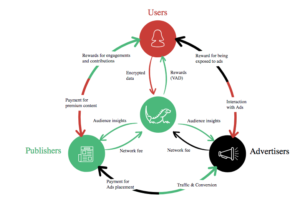
Blockchain technology is the key is achieving all this. As the white paper says, the prototype will work through the Ethereum Network, which the managing team considers the best network available at this stage in the development cycle for blockchain technology. But they will be developing their own blockchain at the same time. They have several solutions to achieving that goal under consideration, and they will be “communicating our test results as well as our final decision” on the basis of the Varanida Blockchain.
However the particulars are ironed out, the idea is to deploy “a crowdsourced advertising validation through the validation by users of the quality of the advertising.” This will be a fraud-proof system, allowing for trust within the triangle of parties just described.
The network fees will be a minute portion of advertising spend. Publishers will be earning more money from the ads they show than at present, because getting onto the Varanida network will mean cutting out the middlemen.
As noted above, the prototype phase involves the VAD token, an ERC-20 token on the Ethereum Blockchain. Users will agree to view ads, and will decide to block certain of the ads, those they deem low quality, from the network. Every time a user blocks an ad, he or she is to be rewarded with a token. Thus, they will be contributing to a list of blocked ads and advertising scripts stored on the blockchain.
Data and Tokens
Users also own their own data. They can agree to share their personal data in encrypted form and thus help guide the network’s advertisers. For this, too, they will re rewarded with tokens. Further, how much data they will share will allow a choice with various levels, rather than “all” or “nothing.”
The network will develop various uses where the VAD earned in this way can be spent. As an important example, users will be able to transfer VAD to publishers and content creators. Varanida envisions content creators welcoming this sort of payment as a measure of independence from direct ad revenue correlated to “clicks.” If so, then content creators will be incentivized toward creating better content rather than “clickbait.”
Over time, too, VAD tokens will become tradeable for other cryptocurrencies, and for fiat currency.
Publishers will also earn VAD tokens based on an auction to take place on a Real Time Bidding platform, so anything they receive from users as described above will be in the nature of a “tip” for reward-worthy content.
Publishers, in turn, will be in a position to offer VAD tokens as incentive for comments on articles, for sharing on social media, or for contributing additional content.
Timeline of the Token Sale
2018
June 26, End of Round 0. Private re-sales had offered 50% discount on tokens. In terms of ratio to bitcoin this meant 0.00000570 BTC/VAD. The result was the sale of 1.46% of the total token supply.
June 27, Round 1, an invite-only round, [though the interested are invited to request an invite] begins. The minimum contribution for this round is 3 BTC, or 30 ETH, and the target is to sell 30.15% of the new tokens. They’re selling at a 30% discount, or 0.00000900 BTC/VAD. Click here to request an invite.
August 15, Round 2, sales open to the public, begin. The public of course is subject to know-your-customer rules. The discount is down to 10%, and the target is the sale of 20.10% of the tokens.
September 15, Round 3, also open to the public. No discount. There is no fixed date for the end of Round 3. Varanida expects to sell a total of 67% of its tokens in these rounds. As to the remaining 33% of the tokens, their distribution shall be as indicated in this graph.

What the VAD is Not
The token sale announcement issued at the start of Round 1 cautioned that a VAD is not any of the following:
- is not a financial instrument, within the meaning of EU Directive 2014/65/EU of the European Parliament and of the Council of 15 May 2014 relating to markets in financial instruments,
- is not proof of ownership or a right of control It does not confer any right on any asset or share in Varanida,
- is not an electronic currency within the meaning of EU Directive 2009/110/EC of the European Parliament and of the Council of 16 September 2009 relating to access to and pursuit of the business of electronic currency institutions,
- does not qualify as a payment service within the meaning of EU Directive (2007/64/EC) of 13 November 2007 relating to payment services in the internal market, nor within the meaning of the (EU) Directive relating to payment services 2 (DSP 2) N° 2015/2366 of the European Parliament and of the Council of 25 November 2015.
VAD is, rather, “a cryptographic token used to run the Varanida Protocol, unregulated, digital asset, issued and controlled by its developers, and used and accepted only by the members of a given community.”
Varanida’s Competition
Since the troubles associated with internet advertising are not secret, it is unsurprising that there have been and still are other projects aimed at addressing those troubles, Further, some of those other projects, like Varanida, employ blockchain technology. We’ll focus here precisely on those, the more direct, competitors.
AdEx, ADX, for example, is a blockchain based ad exchange, created with the expectation that decentralized apps (Dapps) would be build on top of the exchange.
Basic Attention, BAT, is the token associated with Brave, an open source browser blocking ads and trackers. BAT includes a ledger system that anonymously tracks user attention to reward publishers.
But Varanida is importantly different. Both ADX and BAT have centralized the ad blocking function. Advertisers understandably dislike centralized blocking, which they believe essentially involves holding their work for ransom. But Varanida wants to bring the advertisers on board as part of its three-sided system, and to this end Varanida’s system is transparent and decentralized with regard to its ad blocking. Advertisers can buy in, in the belief they’re getting a fair shake and that they can learn and benefit from the feedback they receive through the network.
Also, the Varanida system includes a reputation management feature that is not matched by ADX or BAT. The Varanida platform will “introduce a specific score presented in the form of VADkarma.” Advertisers will build up their VADkarma by proposing high quality ads. Publishers will build up theirs by displaying those ads on websites that meet Varanida’s guidelines on quality, Users, too, will have a VADkarma score, to which they will add as they rate both ads and the quality of websites.
For users, the direction of the score will move only upward, there will be no mechanism by which a user’s score can drop. But for publishers and advertisers, loss of VADkarma will be possible. The idea is to deter the creation or placement of spam.
A Little Jargon
With regard to reputation management, the white paper observes that it involves “a crowdsourcing task with boolean choices.”
Some readers might not be familiar with the phrase “boolean choices,” so here is a very brief tutorial. Boolean algebra is the branch of algebra in which the values of variables are “true” or “false,” usually represented as 1 and 0. The operations of Boolean algebra are AND, OR, and NOT. Thus, George Boole, writing in the 1840s, unwittingly laid the groundwork for the formal description of the operations of a digital computer.
Boolean choice here simply means that users reacting to an ad are doing something binary: thumb up or thumb down on the ad. These binary choices are then aggregated so that there is a binary choice at another level: the ad is either deemed approved or rejected. After the process is complete for a particular ad, that advertiser’s reputational score is either increased or decreased.
A Final Thought
The white paper might have been more forthcoming about the competitive challenges that Varanida will face. For example, Papyrus (PPY), a scalable blockchain protocol with many of the same expressed aims as VAD, seems a closer kin than ADX or BAT. Yet, although PPY is mentioned in the blockchain, it is only just barely mentioned, with a specific opinion, much less a cogent distinction. It would have been a suitable matter for further comment.
Nonetheless, the bottom line is that VAD enters the market to use blockchain technology to fill a need, straightening out the mess that is internet marketing in the later part of the second decade of the 21st century. The mess is real, and the arrow aimed at it seems the right one. The market for those arrows may be large enough to accommodate a number of archers.
Be sure to follow Varanida on social
Telegram: https://t.me/varanida
Twitter: https://twitter.com/Varanida_VAD
Facebook: https://www.facebook.com/varanidaVAD
Reddit: https://www.reddit.com/r/Varanida/
Discord: https://discordapp.com/invite/7CjdaXC
Download the app: https://www.varanida.com/download/
A Blockchain for a Multi Brand Luxury Goods Registration Platform
Arianee, a Paris based startup, offers a new way of managing digital ownership and authenticity in service of distinctive brands. The underlying idea is a simple one and follows directly from the basics of blockchain technology. An asset is published in a unique chain and is linked directly to a single serial number: the burden of vouching for the authenticity of a product is shared amongst all parties engaged in transactions that concern the product. The fact of its authenticity is shared with the world.
The name “Arianee” is the French version of the name of the Greek mythological heroine whom Anglophones call Ariadne. With a thread of glittering jewels, Ariadne is said to have allowed the Athenian, Theseus, to escape the Labyrinth after he had dispatched the Minotaur. The term “Ariadne’s thread” is accordingly in common use in the software world, referencing the exhaustive application of logic to all possible options.
“There could be no better name for a structure committed to helping companies and individuals negotiate the internet – a labyrinth whose challenges far exceed those faced by Theseus – than Arianee,” says the white paper.
It also quotes Ovid:
The door, so difficult, which none of those before could find again,
By Ariadne’s aid was found, the thread that traced the way rewound.
Prosaic Damage
In less poetic moments the white paper includes some statistics on the rise and costs of counterfeiting and piracy. Working from OECD figures: counterfeiting increased from just 1.9% of the total volume of international trade in 2008 to 2.5% in 2013. In absolute terms, that 2.5% represents more than $460 billion dollars. Digital piracy in films along represented $160 billion that year.
Some luxury brands have been very aggressive of late in their pursuit of counterfeiters. But as the white paper observes, prosecuting a party for counterfeit luxury goods, can be a very complicated matter.
Arianee sees this problem as its opportunity or, it its words, “the legal paralysis resulting from the complexity … creates an ideal space” for its own efforts.
Arianee says that its platform will begin with a focus on physical/luxury goods (watches, fashion, paintings). There is no doubt, the white paper says, that “having a digital asset linked to the physical product will significantly reinforce an owner’s or potential purchaser’s trust in the authenticity of the product.”
The white paper quotes Jean-Claude Biver, heav of LVMH’s watch division, saying that “when you break the illusion of prestige, the dream, it takes away the confidence. It means slow death for luxury goods.”
At present, brands maintain customer relationship management (CRM) technologies to track interactions between individuals and the brand’s employees. Unfortunately, the distribution network is fragmentary, and customer records can be unreliable even when (which cannot be taken for granted) they even exist.
Further, if brands do manage to communicate with buyers they can find they are talking to the wrong people entirely since a product may have been purchased as a gift, or it may have been resold on a secondary market. For them, even aside from the questions of piracy etc., the ability to track who owns their branded products and to keep open lines of communication with owners will be a great business model advance.
The Token
The token ARIA is the basis of the Arianee protocol. This is an ERC20 token that will be used to pay for the features on the Arianee protocol that will require payment.
ERC-20 defines basic functionality issues such as how tokens are transferred and how users can access data about a token. It also prescribes two signals that each token takes on. Together the functions and signals ensure that Ethereum tokens of various types in the marketplace can work together: almost all wallets that support ether can support ERC-20 compliant tokens, inclusive now of ARIA.
The ARIA spent by brands will be used to compensate the authority nodes to whom the consortium model gives a role. Another portion will be reserved for platform maintenance and to seed fund promising third-party ecosystem projects that, it is expected, are in a position to provide exceptional value to the Arianee platform. The rest will go to the third party which facilitated the transaction.
Arianee acknowledges that the recent history of cryptocurrencies shows that their value can suffer from wild fluctuations, creating an obstacle for the successful function of blockchain platforms. To provide for this another element, ‘‘Gas,’’ will be used to secure the blockchain and prevent spam and malicious behavior.
Specifically, certain transactions on the blockchain (authenticity certification and messaging) will require payment both in ARIA and in Gas. ARIA can be acquired on the Arianee platform or on exchanges, but Gas is going to be distributed to verified brands, verified experts, and owners, at no cost, and on the basis of need. Each user meeting certain minimal criteria will receive a Gas allotment which can be replenished upon depletion.
The startup sees its ICO as the opportunity to bond together the members of its community. Accordingly part of the tokens will be going to early users who introduce items that require certification.
Click here to express interest in upcoming ICO Token sale
Management Team
Frederic Montagnon is chairman of the board. He has founded four companies, exiting from them with a total value of more than $400 million.
Montagnon is the 7th largest start-up investor in France, and has been active in the cryptocurrency field for five years, as both investor and influential commentator.
The head of business development is Jean-Marc Bellaiche. He is quite familiar with the issue of preserving the value of a brand name: he was formerly senior vice president of Tiffany & Co. He has also been senior partner at the Boston Consulting Group, where he led the BCS luxury, fashion, beauty, and department stores practices.
Head of operations: Christian Jorge, a serial entrepreneur in the field of web agencies and e-commerce.
Important Advisers
Arianee’s advisers include Laurent Salat, the founder of Project Theseus (which certainly keeps matters within the same mythological family). Theseus is a data analysis platform specifically dedicated to blockchains.
Fabien Potencier is also involved. Potencier is the founder of Symfony, the PHP web application framework that, beginning in 2004, has helped speed the creation and maintenance of apps and that has replaced competitive coding drudgery.
Since Arianee straddles the luxury products and high-tech worlds, it is unsurprising that it draws advisors from both of them. Its advisors with a luxury background include Patricia Barbizet, who became the first woman to head the auction house Christie’s when she was named its CEO in 2014. Fortune has ranked Barbizet number 6 in its list of the 50 most powerful women in EMEA.
Those with such a background also include Robert Jan Broer, founder and editor of Fratello Watches, the fine watch aficionado’s website. Broer is also a watch collector of importance.
Protocol
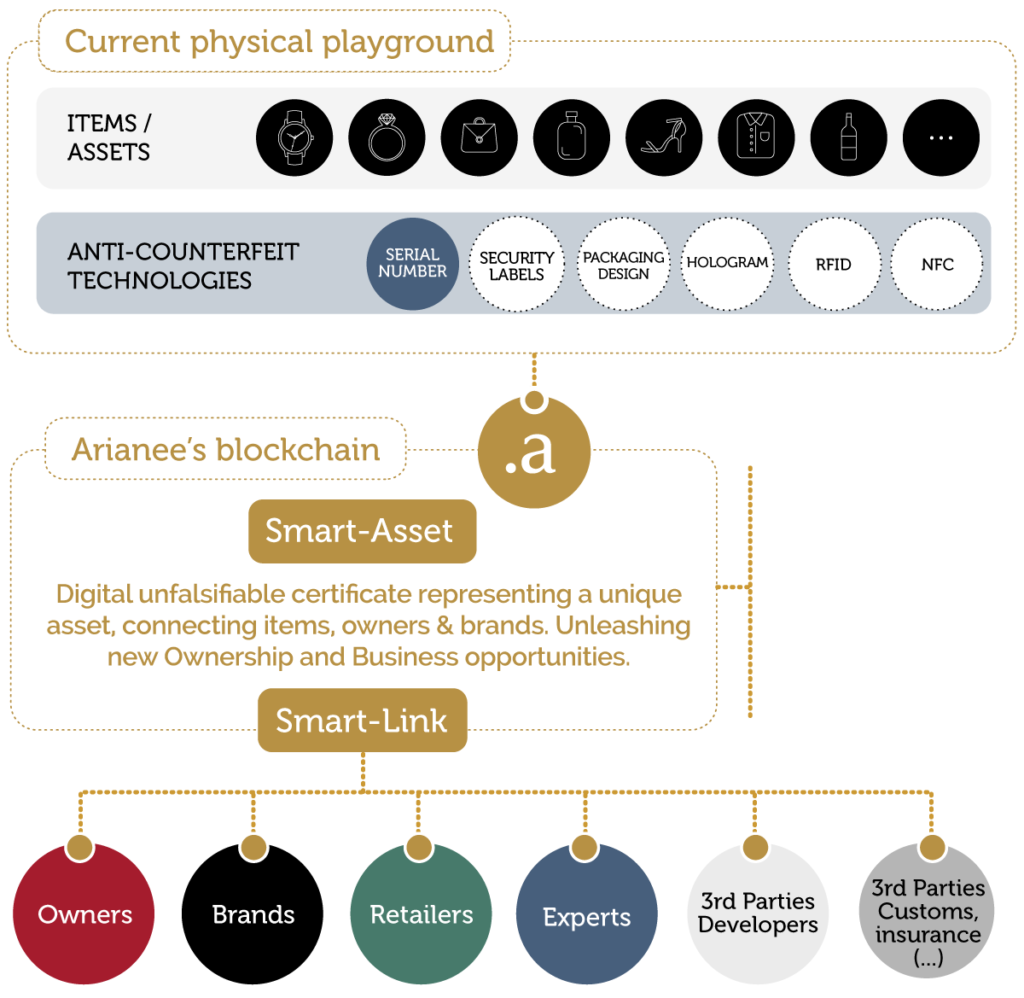
The white paper divides its discussion of the Arianee protocol into three sections, devoted to what it has to offer to, respectively, owners, brands, and the third party community.
The owners will be the primary users of the platform. They’re expected to register their products in the “Vaults,” as “Smart-Assets,” whether by listing the products themselves or by taking possession of the Smart-Asset from another user (owner, brand, or retailer). They can then enrich these Smart-Assets via certificates of authenticity delivered by brands, servicing history stamps from expert third parties, and the like.
It will be possible for an owner to lend out an asset for a definite period of time through this platform. Such a practice “will help define new use cases and build a global ecosystem with other parties.”
Each Smart-Asset will contain a log that will list all associated events, such as when it has been lent out. Owners can grant the right to third parties or brands to read the data linked to assets in the Vaults.
The second type of users critical to an understanding of the protocol are those brands themselves. They won’t have a Vault. What they will have is an Initiate Brand Data Hub. This will provide analytics in three key areas: the management of authenticated products; regular communication with product owners; and interaction with the distribution network (wholesale and retail).
Brands are rewarded for their willingness to issue Smart Authenticity certificates, which as we’ve seen enhance the assets in the owners’ vault. The reward, precisely, is that they then become able to send messages to the current owner of the certificate, whether or not that is the initial buyer.
Brands can grant the right to third parties to read data in their data hub. By allowing this, the platform allows brands to share different types of information about registered assets.
The third type of Arianee user mentioned above is the one with the all-encompassing definition, “third party community.” This includes for example experts outside of the brands, whose appraisals may enrich the products in the owners’ vaults. In order to get an appraisal, an owner will start by searching for “an expert third party who has gone through the Arianee validation process or has received delegation from a verified brand.” The owner can then check the expert’s reputation and grant that party “writing access.” The expert can then add an appraisal certificate to the Smart-Asset in the owner’s vault.
The community also includes retailers, who “need access to mechanisms that will both establish their reputation and protect them from fraud.”
More generally, Arianee expects that “enriching third parties” will develop apps (or, to be precise, Dapps) that will leverage the blockchain.
The platform will be of great benefit to insurance companies. In case of theft of or damage to an insured item that is on the platform, the insuring company will be in a position to verify authenticity and ownership, as well as to establish an accurate repair or replacement cost. They will also be in an improved position to monitor and protect themselves from insurance fraud.
To get insurance, a product owner will first grant the insurer a “read access,” either to its entire vault or to the selected assets for which insurance is desired. The insurer may then use the certificates of ownership and authenticity in the vault to estimate the value of the products involved, and thus the appropriate premium.
Another third party beneficiary of the platform is the IT service provider who will find itself a “necessary bridge between legacy IT systems and the Arianee blockchain.
The Three Models
As the white paper observes, there are three distinct blockchain models. The first, the paradigmatic blockchain, is the “public blockchain,” designed to cut out intermediaries so that everything becomes peer-to-peer. This is what Satoshi Nakamoto was doing in creating Bitcoin, after all.
In such a system, every transaction has to be verified and synched with every node, and anyone “with a computer connected to the internet can set him-herself up as a node.” This is much of the charm of the new technology, but it also has its limitations. Transactions get slower and more costly as the network grows.
An obvious response is to bring intermediaries back in, to some degree, with a “private blockchain.” Write permissions can be centralized to a single authority, and read permissions can be restricted to greater or lesser degree as the needs of the system seem to require. The generally involves one central “miner” of tokens.
Vitalik Buterin, of Ethereum, has described a typical private blockchain as “a traditional centralized system with a degree of cryptographic auditability attached.” This makes it subject to security breaches and it raises the issue of trust. It the context of something akin to the Arianee platform, it cannot be assumed that the owners or brands or other parties involved are going to trust the central authority. That may send one back to the public model, which requires no trust given the redundancy built into it.
But there is a third model, the consortium blockchain. This is an effort to preserve the pluses of each of the other two models. The mining of tokens is decentralized, though there is a miner selection process. There is also a voting or multi-party consensus mechanism (rather than the ‘proof of work’ or “proof of stake’ consensus of public blockchains). Transactions are approved at very short intervals, 100 times a msec.
It is the consortium blockchain model than, Arianee says, is “more specifically aligned with our needs” than either of the others.
Zero Knowledge Proofs
The white paper also references the Ethereum Metropolis (Byzantium) upgrade late last year, which added a new cryptographic tool to the blockchain, the zk-SNARKs. The lower case “zk” refers to “zero knowledge.” This (zk) refers to any method by which one party on a blockchain can prove to another that something is the case without revealing any information other THAN the fact that this something is the case.
The capitalized “SNARK” refers to “succinct non-interactive argument of knowledge,” which is a special variation of zk. SNARK is important in essence because it reduces the amount of computational power necessary for the “prover” to make its point to the “verifier.”
Arianee says that zk-SNARK is a “very important new tool in the Ethereum box that we will be using,” though it is vague about when the use will begin, saying only that it will implement zk-SNARKs “as soon as it will be efficient to do so.”
The gist of the paper’s discussion of zk-SNARK seems to be simply to demonstrate to readers the determination of the Arianee team to stay at the cutting edge of developments in a quickly changing technological setting.
The Timeline
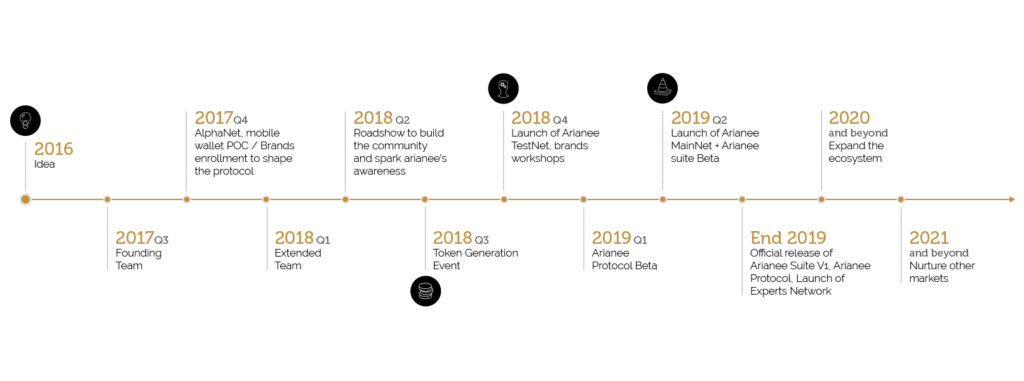
The Arianee website indicates that the founding team first came together in the third quarter of 2017. By the first quarter of 2018, Arianee had its extended team. The second quarter saw a roadshow in which this team sought to build a community and spark awareness of the needs that the platform will meet.
Going forward: Arianee plans to launch its TestNet and brands workshops in 2018 4Q. The first quarter of next year will see the protocol beta. Then, in 2019 2Q, the platform will go live.
Arianee has not yet announced dates for the various rounds of the ICO. US persons are prohibited from participating. As is customary there will be a Round 0 [private sale, to core members and advisors only], a Round 1 [broader participation but by invitation only], and a Round 2 [public sale]. The total ICO won’t last longer than 18 weeks.
There is no hard cap yet for the token sale -- one will be set after Round 0. The soft cap is $20 million.
For the public sale the price will be 5,000 satoshi per token. A satoshi is the smallest fraction of a bitcoin currently in use, a hundredth of a million BTC.
There is a minimum 30% discount from this price in Round 0 ad a 20% discount in round one.
Governance
Arianee’s governance system is a little unusual, a by-product of the fact as noted above that it uses the consortium blockchain model, mixing and matching features of the public and private models.
Arianee’s governance consists of: an executive board, a protocol board, and enterprise committees. They all can be said to supplement the Proof of Authority protocol, the machine-based consensus seeking mechanism that will certify the integrity of the blockchain.
The executive board is in charge of the allocation of the ICO funds and management of the Arianee fund. Through the Arianee fund it will distribute grants to “promising projects developed by the third-party ecosystem.”
The protocol board will be making decisions concerning the development and maintenance of the protocol as described above. Its mandate is to ensure the independence of the network, and the balance of power among authority nodes.
The enterprise committees will give voice to the businesses using the protocol. Each particular business sector involved in the ecosystem gets its own committee, to service the needs of its users, and each committee shall elect a representative to participate in the meetings of the protocol board.
Governance also entails a Know Your Business process through which every brand, expert, and independent authority node operator will be verified. Only verified companies will have access to the paid features of the system. The verification process will be run by another governance body known as the “Network Onboarding Circle,” and will be approved by the protocol board.
Final Thoughts
The working paper discloses a fascinating business plan. And certainly the luxury goods markets -- as well as other markets that might not fit into that designation but could be brought into the same system of authentication over time -- is likely to support measures that will make life more difficult for counterfeiters, black marketers, or grey markets either.
But there are a couple of matters that may give some readers pause. First, Arianee seems not yet to be willing or able to name any brands that have committed to the system. Second, the white paper is not all that clear on what role the “Gas” is supposed to play and how that is supposed to be accomplished.
Yes, it is clear that Arianee acknowledges the volatility of ETH, and so in advance of ARIA as an ERC-20 token, It says that the Gas is introduced to resolve the problems that volatility would otherwise create, but it isn’t immediately clear how that resolution is to work.
Here we conclude, and perhaps instead of Ovid we might quote the simple words of Nathaniel Hawthorne, in his Tanglewood Tales: “Eager to let Ariadne know of his success, he [Theseus] followed the guidance of the thread, and soon found himself at the entrance of the Labyrinth.” We have come a long way and you, dear reader, may now boast of your success to the Ariadnes of your life.
Be sure to follow Arianee on social
Telegram: https://t.me/arianeeproject
Twitter: https://twitter.com/ArianeeProject
Instagram: https://www.instagram.com/arianee_project/
Reddit: https://www.reddit.com/r/Arianee/
Discord: https://discordapp.com/invite/zCm2PBj
Peter Gabriel: From Genesis to Blockchain
Peter Gabriel, the English (Surrey born) songwriter and performer known as one of the founders of that landmark of prog rock, Genesis, and for his epic solo video hit “Sledgehammer” in 1987, is one of the backers of a blockchain startup designed to provide transparency to the food industry.
The German statesman Otto von Bismarck famously compared laws to sausages. The ordinary citizen/consumer is best off not knowing too much about how either is made. But the point of the startup is to challenge the food-industry side of that analogy, on the presumption that in the 21st century a lot of people do want to know about the whole supply chain behind their sausages.
In a statement, Gabriel said that he is convinced the project, Provenance, “is going to find a big role going forward and will be of great use to the consumer” as well as leveling the playing field for “smaller, independent producers” trying to compete with the agri-giants.
A Modest Blockchain Proposal: Reshape Advertising with Varanida's Token Sale
Building a better Internet through a decentralized advertising and content solution.
Blockchain innovator Varanida plans to do nothing less than change the nature of internet advertising. Advertising has long supported the internet, keeping much of it free to users. But with privacy and phishing concerns on the rise, and with the broader and even more dangerous perception that the internet has been hijacked by profit-obsessed click baiters, link farmers, etc., to the detriment of the old dream that ‘information wants to be free,’ it has become clear that internet advertising will have to change.
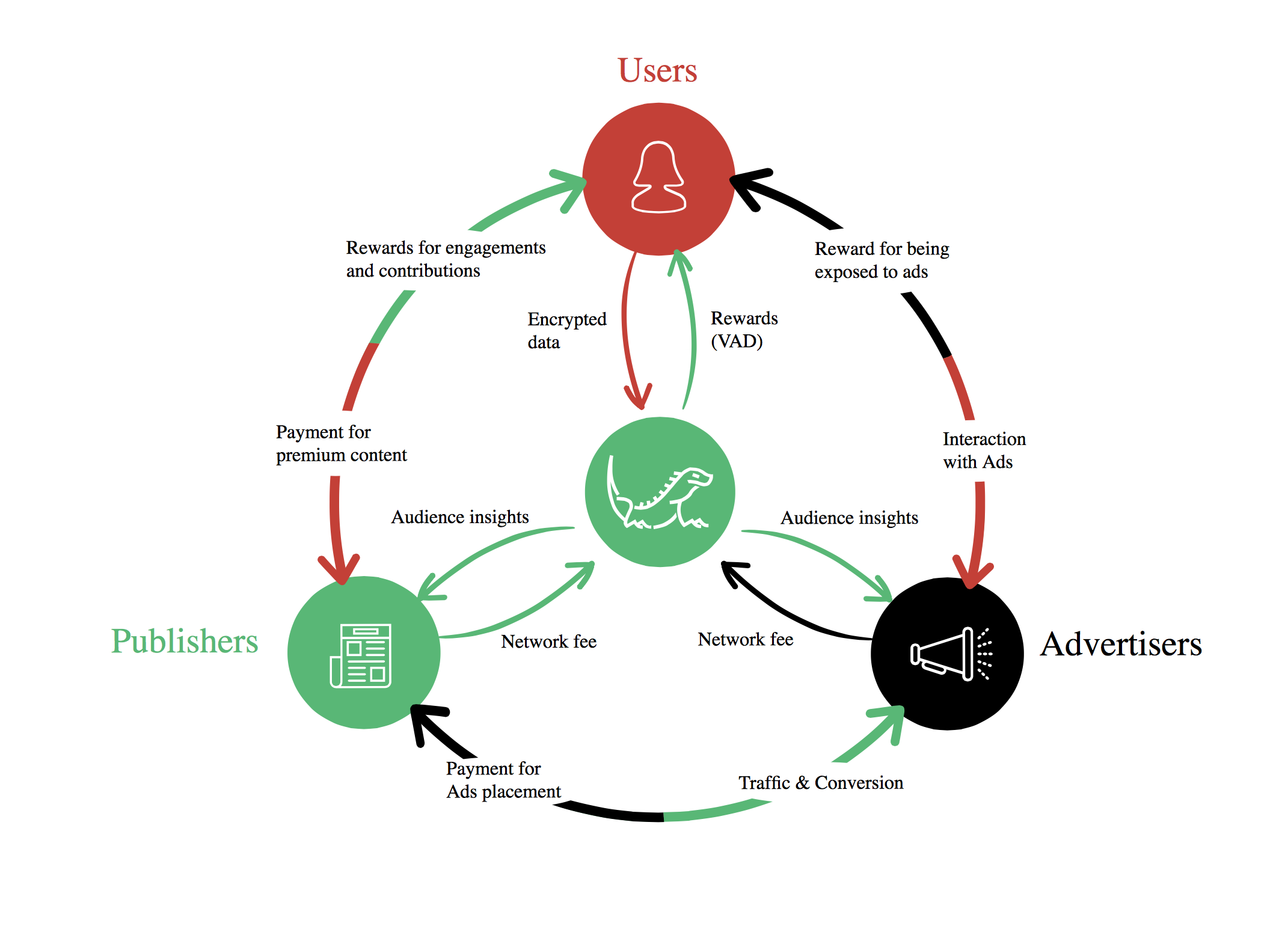
The goal of Varanida is to get out in front of and mold that change.
In broadest terms, the idea is to produce a world in which internet users see the advertising they want to see, given their ability to earn VAD tokens by watching it. So the users win. Also, publishers win by paying a fair value price for their advertising and preserving their engagement with their audience. And the advertisers win, getting a fair and transparent advertising network.
The key to achieving this: blockchain technology. As the white paper says, the Varanida Blockchain will deploy “a crowdsourced advertising validation through the validation by users of the quality of the advertising.” This will be a fraud-proof system, allowing for trust within the triangle of advertisers, publishers, and users.
Varanida issued its token sales announcement on June 27.
On that day, Round 1, an invite-only round, began. The minimum contribution for this round is 3 BTC, or 30 ETH, and 30.15% of the new tokens, VAD, will be sold during this round.
Round 2 is slated to begin on August 15 (unless the maximum amount for Round 1 is hit before then). This will be open to the public, subject to know-your-customer restrictions.
The project’s mother company, Varanida SAS, is headquartered in Lyon, France. One of its early investors and strategic advisors is Joel Comm, the bestselling author of The AdSense Code (2006) and Twitter Power (2009).
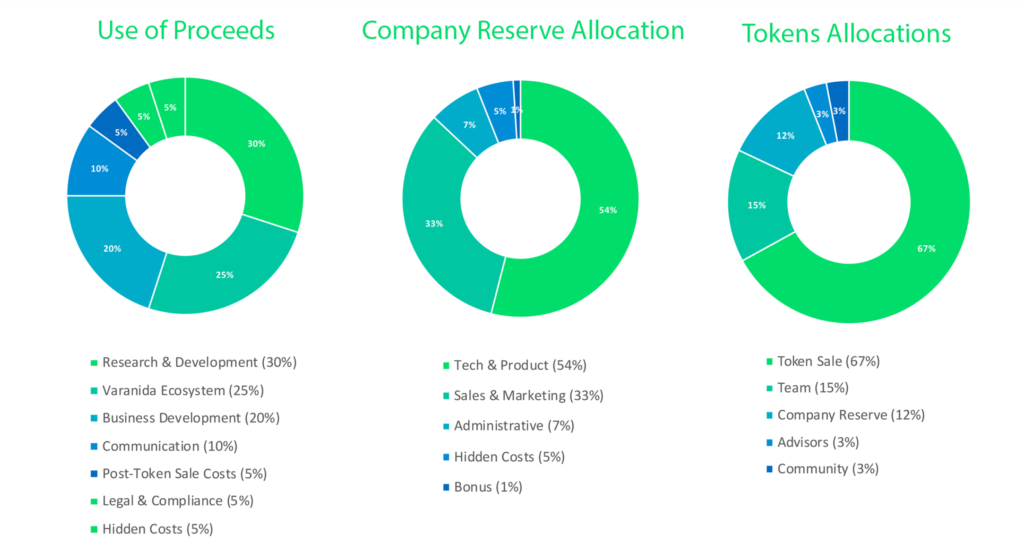
ICO & Token Generation Audience Development Marketing
Source oneQube by Peter Bordes
360-degree audience development and marketing strategies are mission critical to get your brand above the noise as blockchain proliferation accelerates, and the number of companies looking to launch ICO's and Tokens grows exponentially.
Blockchain companies need customized, multifaceted programs, and the ability to execute simultaneously across all organic and paid channels in order to compete effectively for market share. We have developed a proprietary data-driven audience automation software stack for ICO and token generation event (TGE) marketing, and a team of audience architect specialists who are obsessed with developing powerful highly engaged audiences for our partners. Not just for their launch, but for the full life cycle from ICO/TGE launch to post-event to build brand awareness, platform adoption and visibility in their cryptocurrency and token markets.
The cryptocurrency space is becoming exponentially more competitive. In order to have a successful token launch, projects have to communicate their value proposition and connect to relevant audiences at scale. Having a technology partner that has the necessary tools and ability to identify, communicate and engage with token buyers significantly impacts our partner's ability to deliver their message at the right time, right place and right method to their target market.
Launch a Successful ICO / TGE by leveraging our Audience Development and Engagement Platform
The blockchain space is in its nascent days and many of the marketing tactics deployed in other industries are not effective. The use of antiquated siloed mass marketing tactics are ineffective compared to the hub and spoke ecosystem approach developed by oneQube. For instance, when looking at any given ICO / TGE, a company cannot expect to effectively rank their keywords in a timely enough fashion to achieve the desired result. If they are not leveraging and syncing all channels simultaneously to accelerate their keyword ranking trajectory.
OneQube focuses on driving direct and measurable results for our partners. We use a combination of Organic Audience Development, Paid Social Media, Organic Community Management, Email Nurturing, Community Activation, Content and Social Amplification to drive interested parties to their website to learn more about their project and drive conversions.
Establishing trust and credibility within your community and potential users of the platform is key to a successful token generation event. Together with our clients, we put great effort into building trust with the audience. Creating a highly engaged passionate audience, and enabling our partners to harness the powerful collective network effect of that audience.
We leverage our network of thought leaders and add additional exposure through networking our partners with advisors and business development relationships to help our customers build their business, increase their visibility, reach their target token buyers and successfully convey their message.
oneQube ensures our clients build the reputation and awareness for their token to have the most successful project launch. As well as developing and executing a post-event marketing strategy to build their business and cryptocurrency markets.
Omega One, Trade Execution, and a Diagnosis
Omega One's vision is to build a bridge between traditional markets and digital assets, using world-class technology and trading algorithms. By improving liquidity and security in digital asset trading, we are laying the groundwork for a more efficient, decentralized and inclusive financial system.
On June 21, 2017, on one of the world's largest crypto exchanges, the price of ether fell 99.9% in less than a second, before rebounding just as quickly.
Omega One's Alex Gordon-Brander explains how this crash happened and how a liquidity solution like Omega One's could prevent these kinds of crashes in the future.
Omega One, a trade execution system that will use a crypto-economic protocol mediated by the Omega token (OMT), launches this summer. The token will be on sale from June through August, with the goal of $110.5 million. The system and the tokens are part of a project to resolve issues of illiquidity, insecurity, and opacity and thus to advance the mainstream appeal of cryptos.
This report on the Main Bloq looks at a number of the considerations that bear on whether that project will succeed, what the risks are, and what will be the rewards. We will be working in large part from the Omega One’s white paper.
The management team is of impressive pedigree.
The Two CEOs
Alan Keegan was the CEO when the Omega One white paper was drafted. He has since stepped down from that post but remains active with the title of co-founder. Keegan previously worked at the world’s largest hedge fund, Bridgewater Associates, as an expert on currencies and cryptocurrencies. There, his research and observations about historical trends and market conditions were studied by senior central bankers and global policymakers around the world.
Alex Gordon-Brander, of Bridgewater FX Trading and Tech, is the new CEO. When he was at Bridgewater, he managed portfolio construction apps and wrote the specifications for algorithmic trading. The smart order routing of the system he introduced there saved money for clients of that huge hedge fund manager by breaking up their large currency orders.
Smart routing is also, as it happens, an important issue in the cryptocurrency world. Indeed, in a sense, smart routing is critical to the program since if Omega One is not able to fill a trade from orders in its own dark pool, it will route the trade in whole or parts to other exchanges around the globe to complete. The Omega One white paper calls this process “liquidity harvesting.”
Before he went to Bridgewater, Gordon-Brander was with MarketAxess, and while there he acquired a patent on the MarketAxess bond trading platform.
Gordon-Brander’s LinkedIn profile says that he has been “designing alternative currency systems since before the Bitcoin white paper.”
Other Critical Team Members
Omega One’s technology partner is ConsenSys, the world’s largest blockchain company. Gordon-Brander was formerly Chief Business Architect there.
Daniel Flax is Omega One’s Chief Technology Office. He has been the CIO at Cowen and Co.,; the CTO at The Street; Vice President, Engineering, at CAN Capital; and managing director of trading systems at the New York Stock Exchange. At the NYSE he led a transition to digital trade execution and settlement.
Ron Garrett is Omega One’s chief operations officer. He has the additional title “ConsenSys Liaison,” which is itself revealing of the close connection between the two entities.
Joseph Lubin, who is both the founder of ConsenSys and a co-founder of Ethereum, is an advisor to the Omega One team. Back at the turn of the millennium, Lubin was a VP Technology, Private Wealth Management Division, Goldman Sachs. He left there to join a startup, Blacksmith Applications, which was developing trade management and processing solutions for a range of corporate clients. Lubin directed their New York office.
Two Important Advisers on Compliance Issues
Bart Chilton, a former Commodity Futures Trading Commissioner will be advising Omega One on compliance issues. From 2001 to 2005, Chilton was a senior advisor to Senator Tom Daschle (D-SD), before working at the Farm Credit Administration and eventually (2007) receiving George W. Bush’ nomination to the CFTC.
While at the CFTC, Chilton took a special interest in allegations of the illegal cartelization of the precious metals markets and their derivatives. An activist in this field, a board member of the Gold Anti-Trust Action Committee, has described Chilton as “the modern-day equivalent of Eliot Ness.”
Such a concern with the integrity of the gold and silver markets is pertinent to Chilton’s interest in Omega One’s project. After all, many people who are distrustful of the post-Nixon system of “fiat money,” and who fear the failure of that system, tend to look toward the markets in precious metals as a hedge against fiat failure. That fear has also, in recent history, been one motive for interest in alternative or cryptocurrencies.
Juan Llanos is on the advisory board of the Wall Street Blockchain Alliance. He maintains a blog, ContrarianCompliance.com, where he discusses cryptocurrencies, blockchains, and regulators.
In that blog he has emphasized that a rule of “know your customer” (KYC) has morphed into both “Know Your Transaction” (KYT) and “Know Your Funds Flow” (KYFF). In the course of his career, Llanos has helped devise a number of innovative financial products, including Mexico’s first prepaid debit card. More recently, Llanos led Bitreserve strategies on compliance and transparency.
In 2008, Llanos received permanent residency in the United States in recognition of his “extraordinary ability” in anti-money laundering and countering the financing of terrorism.
A final note on compliance: Omega One says that it is working with the law firm of Debevoise & Plimpton as well as with ConsenSys’ lawyers on meeting legal and regulatory mandates.
Debevoise is one of the leading law firms in servicing FinTech. Its part of the Blockchain Legal Industry Working Group created last year by the Enterprise Ethereum Alliance, and it has its own FinTech focused podcast, with the wonderfully apt blockchain-world name, “Appetite for Disruption.”
How is John Mack Involved?
John Mack, a former CEO of Morgan Stanley, though not a member of the management team, is an enthusiastic backer of the Omega One project and an investor. A year ago, he told a Bloomberg reporter that he had been “watching and investing in the cryptocurrency market over the last several years, and … I find Omega One to be an important next step in the emergence of this new economy.”
Mack’s involvement has certainly helped mainstream the Omega One project. But enough about the people involved in the project. What is the project? Specifically, what problems does it hope to solve?
Illiquidity, Security, Opacity
The big problems faced today by cryptocurrency markets and the parties engaged in them are, as the Omega One team sees them, as follows:
- Illiquidity, causing the realized costs of trading to climb at times to multiples of published commissions and fees;
- hacking/security risk, which especially afflicts the most liquid of cryptocurrency markets; and
- A lack of transparency, leaving parties unclear about the actual costs.
Omega One would increase liquidity by offering “a private dark pool and trading algorithms connected to all the world’s crypto exchanges.”
As of the summer of 2017 the estimated value of all crypto hacked from exchanges was above $2 billion. Omega One would improve security by “intermediating between blockchain wallets and on- or -off-chain exchanges with our own balance sheet.”
Further, it would heighten transparency by offering benchmarking and analytics to its members that would “allow them to audit the market impact of their trading.”
Some Trade Execution Particulars
The solution to the above listed problems involves a seven-step trade execution process, understood thus: a member enters a “parent order” trading against funds in the Omega Wallet; the fund availability will be verified; the parent orders will then be turned into “net orders” in the internal matching engine; based on the trading engine’s assessment of available liquidity it will break chunks of these net orders into “child orders”; these will then be broken down further into “street orders” -- these are the actual orders that are executed on an exchange; the public exchange will fill the order, thus adding funds to or withdrawing funds from the balance sheet manager; the Omega One Wallet and the Omega Private Exchange will then take care of the settlement (the back office work, as we used to call it when people were involved in it); and finally, the private exchange will confirm the transaction with the member via user interface/API.
The Omega One Wallet is “a decentralized, trust-less and non-custodial portfolio … made up of a set of linked wallets on multiple blockchains” including Ethereum, Bitcoin, and Omni. What’s new and significant about the Omega wallet, versus other wallets, even decentralized ones, is its built-in interface to the remainder of the Omega ecosystem, which will allow for secure automated settlement.
When the Omega Private Exchange receives an order, it will automatically verify and lock the funds in the relevant wallet, thus shielding the Omega One membership from settlement time mismatches across blockchains. In an ETH-BTC transaction, for example, “the member’s BTC will settle to her wallet on the bitcoin blockchain before the ETH leaves her wallet on the ethereum blockchain, enabling truly trustless listing.”
The Omega One website says, “There have not yet been any pre-sales, main sales, or tokens created at this point. Token mechanics and participation requirements (including whitelisting) will be released shortly before the token launch. Any information you may have seen about token details is inaccurate.”
The Diagnosis is a Sound One
Omega One is certainly right in its diagnosis of the difficulties that cryptocurrencies face if they are to become a mainstream investment option. A recent report by Context Capital Partners looked into investment sentiment as of the start of 2018. It said that 70% of institutions surveyed planned to increase their exposure to “alternative investments” in general in 2018, largely because the bull market in many traditional asset classes is looking old and weary.
Despite this hunger for non-traditional investments, there is still a great resistance (says the Context report) to cryptos. Only 11% of the institutions surveyed are looking to add cryptos to their portfolios. That is a sizeable niche, but it is still a niche. By way of contrast, 51% of those surveyed are planning on a greater allocation to ESG strategies this year.
So: why only 11% for cryptos? Some commentators have attributed the resistance to ‘media bias’ and some to non-rational psychological issues. But to a great significant extent the resistance is perfectly rational and it turns on exactly the three problems that Omega One has identified and addressed.
Omega One says in its white paper that it is the institutional asset managers whose buy-in “will take the crypto markets to the next level of maturity.” Its proposed trade execution system is designed to make that buy-in painless.
Omega One’s approach to addressing these problems is right. Predictably, then, it is not entirely unique. Their most direct competition comes from Ox, an exchange protocol on the Ethereum blockchain that boasts many of the same features, though with less formidable infrastructure. They are also in effect competitors with Kyber Networks (KNC). Kyber’s ICO closed on September 17, 2017. Kyber is a decentralized exchange that focuses on crypto-assets conversion.
The Wisdom of Cyber Spatial Crowds
The question of how to compare those three networks, and others with related functions, as platforms or as investments, has been much discussed on social media, inclusive of reddit.
A Reddit Exchange of Views
An exchange of views on Reddit offers a good display of what the relevant public is thinking about when it compares these systems. In that exchange, in September 2017, “self ETH trader” said that these networks are all “essentially trying to solve the same problem” and asked for guidance on “which has the most potential to succeed.”
One of the views expressed on the resulting chain was that Ox has the more realistic business plan because it is going to “deliver something soon, gain market share and then be able to iterate on the product and improve over time.”
But another participant, Voltaire585, said that he likes “the Omega One strategy for liquidity where they would fulfill your order on a non-decentralized exchange if they couldn’t settle on their order book, which will give them the training wheels till their order book is big enough to sustain itself.”
And another view, expressed by “ethfanman” was that Kyber has the inside track, because they “will support cross-chain trading in 2019 according to their roadmap, so it is not ERC-20 only.”
Jackson Palmer’s Analysis
Jackson Palmer, best known as the creator of Dogecoin, and now the proprietor of a YouTube channel on cryptocurrency with more than 25,000 subscribers, has posted a 23 minute video, picked up by CryptoGeeks.com, discussing the issue.
Palmer says that competition is heating up in the market for decentralized exchange in the Etherium space, and in his video he runs through the major players, beginning with exchanges that use old-fashioned order books. It is at about 11:20 in the video that our host comes to the issue of decentralized exchanges that dispense with order books and that trade by identifying “reserve contributors.” He begins this portion of his discussion with Kyber.
Palmer observes that this requires a KYC inquire for any reserve contributor, and he suggests that they inquiry might be scary to some potential parties.
A broader issue with such an arrangement, he adds, is that “as a buyer, you don’t have a lot of control. You basically have to agree to whatever the reserve operators are setting as the price.” The reserve operators may compete in a healthy way, but that needs to be “tested in practice.” Palmer also expresses some concern that the managers of Kyber have not been entirely transparent.
Palmer’s video doesn’t get to Omega One until about 17:30 into the discussion, and once there he begins by saying that it might not be considered a “decentralized exchange” properly speaking at all, though it has many of the same characteristics. Despite the semantic quibble, he is favorably impressed that Omega One draws upon the centralized exchanges to assist its own liquidity needs as necessary.
After making that point, he says that “the really cool thing that I see about Omega One is that you get all the benefits of a decentralized exchange” but the cost, time efficiency, and liquidity of centralized exchanges.
In general, he also says, “it’s going to take awhile to perfect” blockchain technology, cryptocurrencies, and the decentralization that many see as the promise of them both. Near the end, at about 21:30 Palmer says that the features of Omega One will likely allow it to move to cross-chains more smoothly than its competitors.
The Timeline
Cross-chains are key at this point in the development of the industry. One might argue that what the world of cryptocurrencies needs, more even than the mitigation of any or all of the three important problems listed above, is this: to become one financial space, not several. What it needs is the exchange of one cryptocurrency for another, across a very wide range of cryptos, the exchange of a ETH for a Ripple’s XRP, in a seamless and trustless way.
OMT is, as the Omega One white paper says, “ERC20 compliant with the aim of being able to leverage the functionality of the Ethereum blockchain as much as possible and seamlessly interact with other ERC20 tokens.”
The Omega One road map looks forward to a Release 1.1 - 1.x, no sooner than the final quarter of this year when the team will introduce “additional crypto crosses.” They also expect to introduce fiat currencies into the mix. In their words, that will entail bridging “the fiat/crypto membrane.”
Relatedly, the team also looks forward to adding analytic power at 1.x. “A central source recording meaningful data and interacting 24/7 with crypto exchanges will go a long way toward filling the data gap in the crypto markets” so all participants get the data they need to continue innovating.
That membrane is a legal/regulatory one as well as a technical one.
Even beyond that, Omega One looks forward to becoming a utility. Release 2.0 would depend on “technical development in the broader crypto ecosystem including improvement in the efficiency of double-blinding smart contracts, and the movement of liquidity to reliable, fully decentralized exchanges.” If this happens, then completely non-custodial and trustless liquidity will move freely through the Omega One platform, safe from information leakage or front running.
That plus a self-improving artificial intelligence trading logic engine, which could allocate OMT as fees back to member “who had a meaningful impact on improving trading logic,” would make the platform “a community owned and run a public utility.”
Why didn’t Omega One launch last year?
Omega One had planned the launch of its product and the ICO for last year. Why no launch yet?
Management has said it decided to split its capital requirements into two buckets. Rather than fund everything through a token sale, it would fund product build and launch costs through equity capital, and thereafter fund balance sheet and membership incentives through token sales. This meant that it made sense to postpone the token sale until there was a completed product and those membership incentives had immediate significance.
The distinction between these buckets was already implicit in the white paper issued before the decision was made the make the separation between them a chronological one. The white paper discussed product build and launch costs, including staff salaries, office space, equipment, etc. But the paper also said that its “primary need for capital” was “to build a large enough balance sheet that we can provide risk intermediation and settlement facilitation for a meaningful volume of daily trades.” Risk intermediation requires offsetting trades and that in turn means that the trading limit must be proportional to the size of the balance sheet.
A Final Thought
Omega One will be testing whether traders really demand a low-vol market, that is, one where even transactions large by today’s standards will have little impact. Much of their white paper is devoted to working out examples of how big an impact specified transactions can have, in a spirit of: isn’t this awful?
If there are a lot of traders who think that is, in fact, awful, then Omega One is a great play. But if the world of cryptocurrency turns out to be more accepting of volatility than this team believes, if the community has learned to shrug at such examples as just the-way-things-are, then Omega One’s near future could be a very rocky one.
Omega One WHITE PAPER 


The Regulatory System(S) And Cryptocurrencies
Source oneQube by Christopher Faille
Edmund Mokhtarian and Alexander Lindgren have written a fascinating discussion of “operational issues and best practices” for cryptocurrency traders. As part of this broader discussion, they have provocative things to say about the regulatory system in the U.S. and about where, if anywhere, bitcoins and other cryptocurrencies fit into it.
The regulatory system in the United States is both fragmented and functional. There is no single administrative body whose job it is to oversee the capital markets as a whole, working toward efficiency on the one hand and working against fraud on the other. Instead, there are several agencies involved in this task or these tasks, the most important of which (the Commodity Futures Trading Commission and the Securities and Exchange Commission) are distinguished from each other by the sort of investment vehicle they oversee. As the names suggest, the CFTC oversees commodities trading, the SEC securities trading.
The fragmentation is “functional” in character in that the distinction is defined by the function the two types of instrument perform. Commodities and securities have much in common. They are both traded on markets, they are both quite liquid, and they both serve both profit seekers and risk hedgers. But what distinguishes them? Seventy years ago the Supreme Court gave the following ffunction definition if a security: it is an instrument by which “a person invests his money in a common enterprise and is led to expect profits solely from the efforts of the promoter or a third party.”
The Function of a Security
By design, that definition is very broad, in order to make it difficult for security fraudsters to escape responsibility by saying that they aren’t really securities fraudsters. The function of a security, whether called a stock or bond or something else, is to allow an investor to gain exposure to the gains of an enterprise (commonly a listed corporation) without making any further ‘effort’ other than the infusion of the money itself.


